10.7 Medical Specialists, Diagnostic Testing, and Procedures Related to Blood
Medical Specialists
Hematologist
A hematologist (hē-mā-TŌL-ō-jist) is a physician who specializes in diagnosing and treating blood disorders.
To learn more about a career as a hematologist, visit the American Medical Association’s specialty profile on hematology.
Phlebotomist
A phlebotomist (flĕ-BOT-ŏ-mist) is medical professional trained to withdraw blood or perform blood transfusions. After the blood is collected, it is analyzed by a medical laboratory technician.
Read more about a career as a phlebotomist at Cleveland Clinic’s web page titled Phlebotomist.
Medical Laboratory Technologist/Scientist/Assistant
Medical laboratories employ a variety of individuals in technical positions. Specialized positions are as follows:
- Medical technologist (Mĕd-ĭ-căl Tĕk-nŏl-ŏ-jist) (MT): A medical professional who tests and analyzes blood, other body fluids, and tissue samples.
- Medical laboratory scientists (Mĕd-ĭ-căl LĂB-ŏr-ă-tŏr-ē Sĭ-ĔN-tĭsts) (MLS): A medical professional who performs complex analyses of tissue, blood, and other body fluids.
- Medical laboratory assistants (Mĕd-ĭ-căl LĂB-ŏr-ă-tŏr-ē ă-Sĭs-tănts) (MLA): A medical professional who assists in receiving, preparing, testing, and processing specimen samples.
Read more information about these careers at the American Society for Medical Laboratory Science’s web page called What is a Medical Laboratory Professional?
Diagnostic Testing and Procedures
Apheresis
In traditional blood donation, a unit of whole blood is taken from a donor and sent to a laboratory, where it is separated into its four components: red blood cells, white blood cells, platelets, and plasma. The components are stored and administered to patients who need blood products transfused after surgery, after a severe injury/trauma, or to treat a severe disease or hematological condition. In contrast, during apheresis (ăf-ĕ-RĒ-sĭs), a specific component is removed from a donor’s blood, and the remaining components are returned to the donor while they are still connected to the machine.[1]
Donor apheresis takes longer than a whole blood donation but is easy and painless and has many benefits. For example, an apheresis double red-cell donation (called erythropheresis) separates red blood cells and returns the remaining “non-targeted” plasma and platelets to the volunteer donor. This allows for the collection of twice as many red blood cells from one donation as they would in a whole-blood donation. As another example, a platelet apheresis donation can provide as many platelets as those obtained in four to six whole-blood donations.[2] See Figure 10.12[3] for an image of an erythropheresis machine.
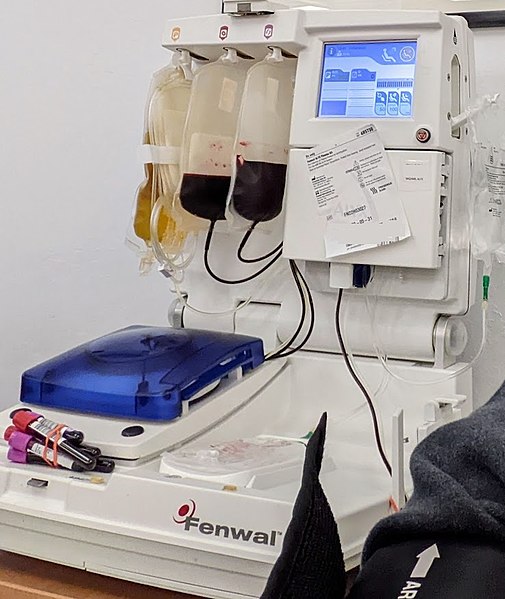
Blood Product Transfusion
A blood product (blŭd prah-DUHKT) is any therapeutic substance derived from human blood. Types of blood products include whole blood, packed red blood cells (PRBCs), individual factor concentrates, fresh frozen plasma (FFP), platelet concentrates, and cryoprecipitate (i.e., plasma rich in proteins). Transfusion of blood products is a common procedure with nearly 16 million blood components transfused each year in the United States.[4] Nurses typically provide blood transfusions after they are prescribed by a health care provider.
In severe cases of symptomatic, severe anemia (i.e., dyspnea or chest pain) or hemoglobin levels less than 7 g/dL, transfusions of red blood cells are prescribed to rapidly increase hemoglobin levels. See Figure 10.13[5] for an illustration of a bag of red blood cells. Note the blood type (i.e., A, B, AB, or O) and the Rh factor positive or negative) are indicated on the label to compare with the patient’s lab results. Health care agencies have strict safety procedures that nurses and other health care personnel follow when providing a blood transfusion to prevent the administration of incompatible blood to a patient.
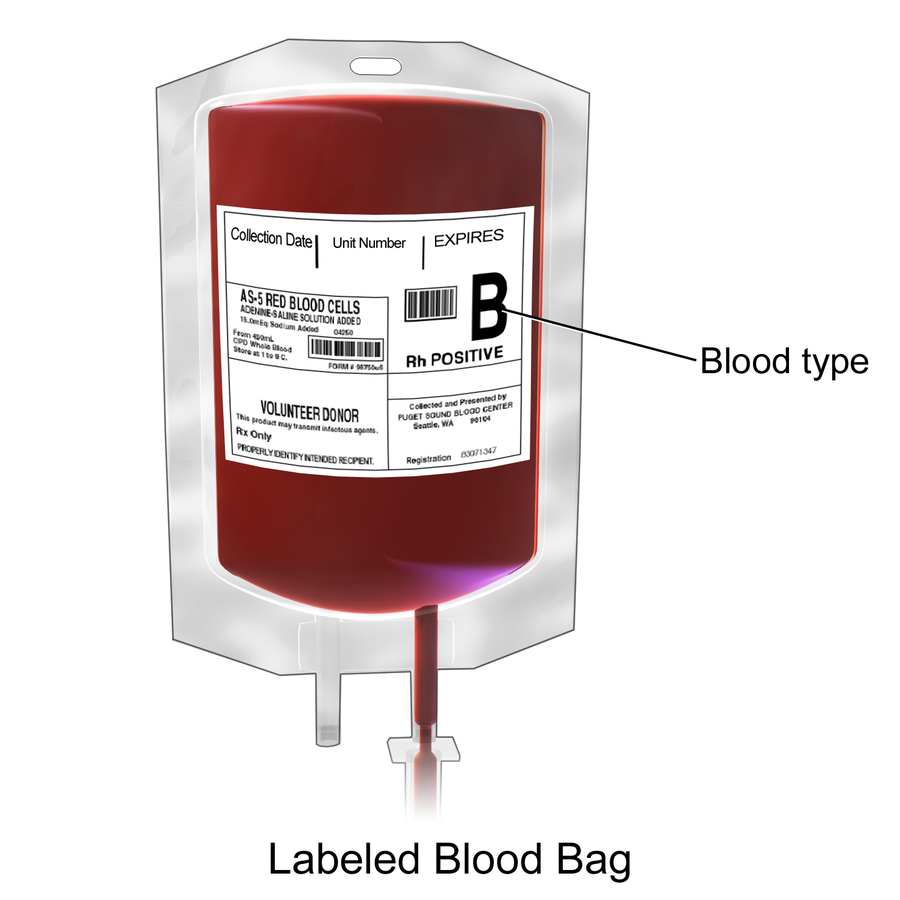
Bone Marrow Aspiration and Biopsy
Bone marrow aspiration (BŌn MĂR-rōw ă-spĭ-RĀ-shŏn) involves the extraction of a small sample of liquid bone marrow from the center of a patient’s bone. Common sites for bone marrow aspiration include the pelvic bone and sternum. The procedure is typically performed after local anesthesia is administered, and then the provider inserts a needle into the bone marrow space and draws out a liquid sample. The aspiration allows for laboratory analysis of the cellular components of the bone marrow (i.e., red blood cells, white blood cells, and platelets). Bone marrow aspiration is helpful for determining the presence of severe blood disorders, such as leukemia, and is also used to monitor disease progression or treatment effectiveness.[6]
Bone marrow biopsy (BŌn MĂR-rōw BĪ-ŏp-sē) involves obtaining a small core of bone and marrow tissue from the bone marrow space. The procedure is often performed in conjunction with bone marrow aspiration.
See Figure 10.14[7] for an illustration of a bone marrow biopsy.
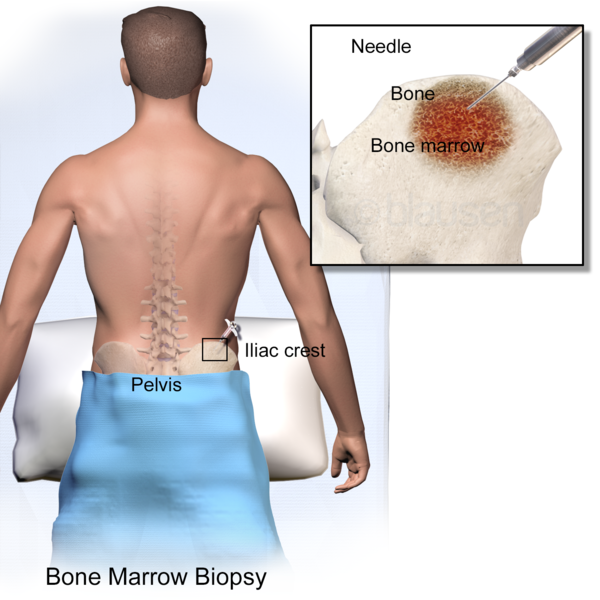
In contrast to the bone marrow aspiration procedure, the provider uses a larger needle during bone marrow biopsy to remove a cylindrical section of both the bone and marrow. See Figure 10.15[8] for an image of a bone marrow biopsy needle. Bone marrow biopsy provides a comprehensive evaluation of the bone marrow, allowing for a closer assessment of the bone marrow’s cellular density, structure, and the presence of any abnormal or diseased cells. It helps diagnose a wider range of conditions, including non-hematological disorders like metastatic cancers and immune diseases that may infiltrate the bone marrow.[9]
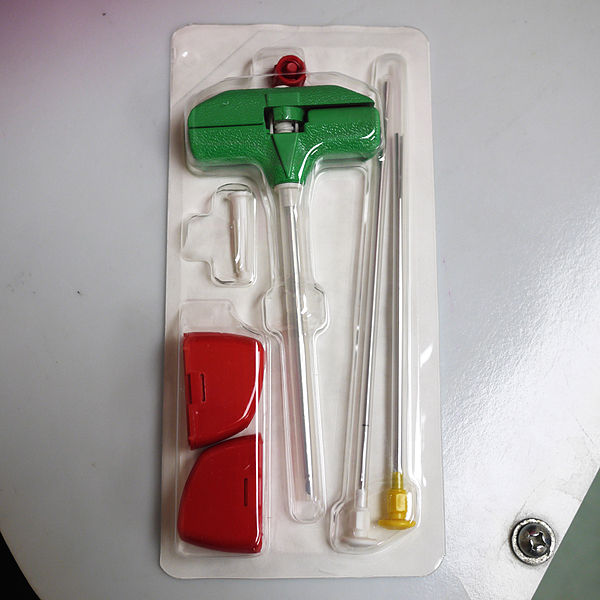
Bone Marrow Transplant/Stem Cell Transplant
Bone marrow transplant (BŌn MĂR-rōw TRĂNS-plănt), also called stem cell transplant (STĔM Sĕl TRĂNS-plănt), is a potentially curative treatment for severe hematological diseases like sickle cell disease, as well as cancer like leukemia. It typically involves the administration of chemotherapy to destroy the patient’s existing bone marrow and then replacing the bone marrow with healthy stem cells donated from a compatible donor. If successful, transplantation can be curative and result in the patient’s bone marrow taking over the production of healthy red blood cells, white blood cells, and platelets. However, patients undergoing this procedure with donated stem cells must take immunosuppressive medication for the remainder of their lives.[10]
Complete Blood Count
A complete blood count (kŏm-PLĒT BLŬD kownt) (CBC) is a blood test performed in a laboratory that provides a comprehensive assessment of various blood components, including RBCs, WBCs, platelets, hematocrit (HCT), and hemoglobin (Hgb). These parameters help evaluate the overall health of the hematological system and can indicate anemia, infection, or other blood disorders. A CBC with differential (CBC wĭth Dĭf-ĕ-REN-shăl) includes an additional measurement of the different types of white blood cells (i.e., neutrophils, lymphocytes, monocytes, eosinophils, and basophils). See Figure 10.16[11] for an illustration of CBC with differential test results indicated behind a tube of drawn blood.
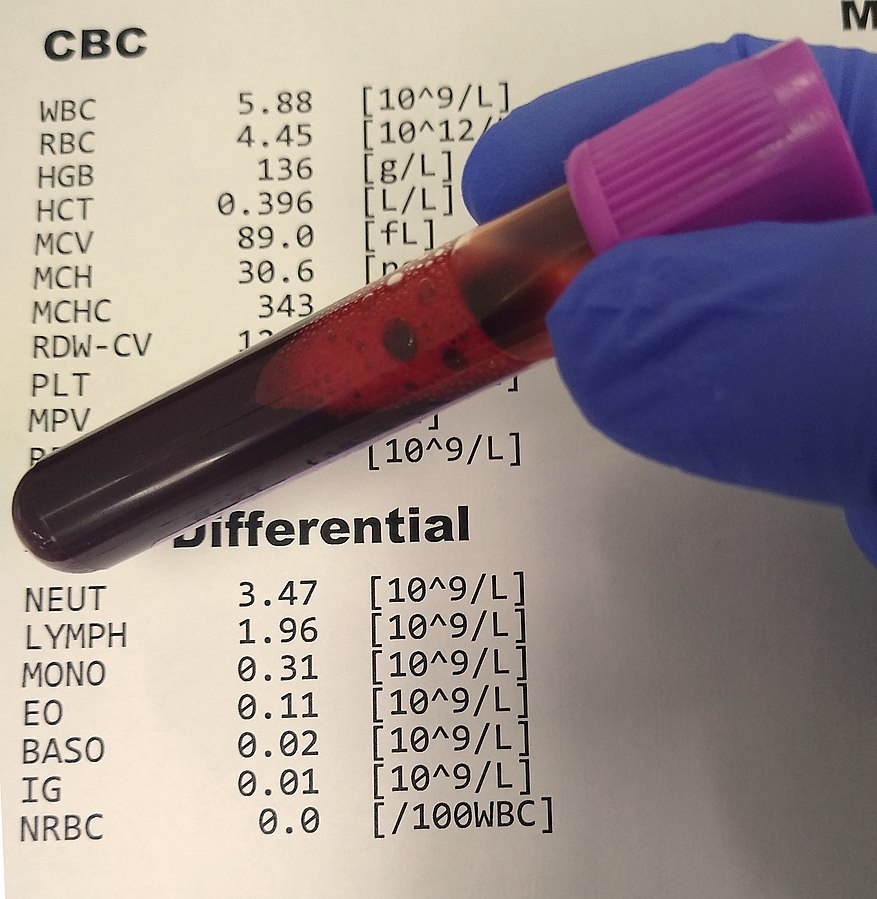
- Yale Medicine. (n.d.). Apheresis. https://www.yalemedicine.org/conditions/apheresis ↵
- Yale Medicine. (n.d.). Apheresis. https://www.yalemedicine.org/conditions/apheresis ↵
- “Fenwal_Erythropheresis_machine_for_plasmapheresis.jpg” by Elwood P. Dowd is licensed under CC BY-SA 4.0 ↵
- American Red Cross. (n.d.). Importance of the blood supply. https://www.redcrossblood.org/donate-blood/how-to-donate/how-blood-donations-help/blood-needs-blood-supply.html#:~:text=Facts%20About%20Blood%20Needs&text=Approximately%2029%2C000%20units%20of%20red,each%20year%20in%20the%20U.S ↵
- “Blausen_0086_Blood_Bag.png” by Blausen.com staff (2014) at “Medical gallery of Blausen Medical 2014.” WikiJournal of Medicine is licensed under CC BY 3.0 ↵
- A.D.A.M. Medical Encyclopedia [Internet]. Atlanta (GA): A.D.A.M., Inc.; c1997-2023. Bone marrow aspiration; [reviewed 2022, Apr 9; cited 2023, Nov 5]. https://medlineplus.gov/ency/article/003658.htm ↵
- “Blausen_0097_BoneMarrowBiopsy.png” by Blausen Medical Communications, Inc. is licensed under CC BY 3.0 ↵
- “Multi_Purpose_Bone_Marrow_Biopsy_Needle.jpg” by Thirteen Of Clubs from Minneapolis is licensed under CC BY-SA 2.0 ↵
- A.D.A.M. Medical Encyclopedia [Internet]. Atlanta (GA): A.D.A.M., Inc.; c1997-2023. Bone marrow biopsy; [reviewed 2022, Apr 9; cited 2023, Nov 5]. https://medlineplus.gov/ency/article/003934.htm ↵
- National Cancer Institute. (2023, October 5). Stem cell transplants in cancer treatment. National Institutes of Health. https://www.cancer.gov/about-cancer/treatment/types/stem-cell-transplant ↵
- “Complete_blood_count_and_differential.jpg” by SpicyMilkBoy is licensed under CC BY-SA 4.0 ↵

